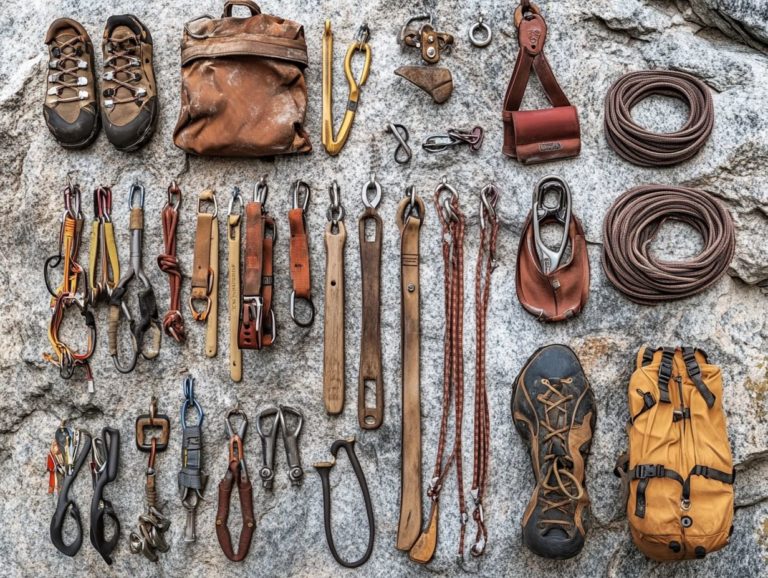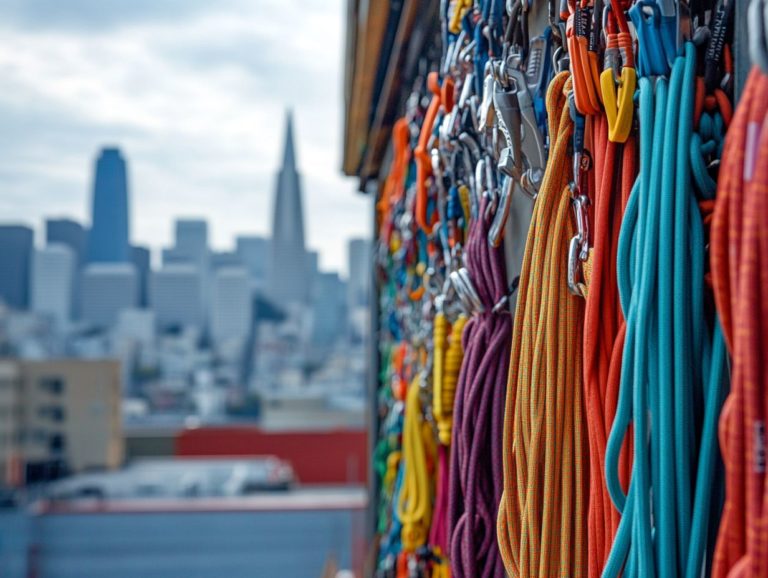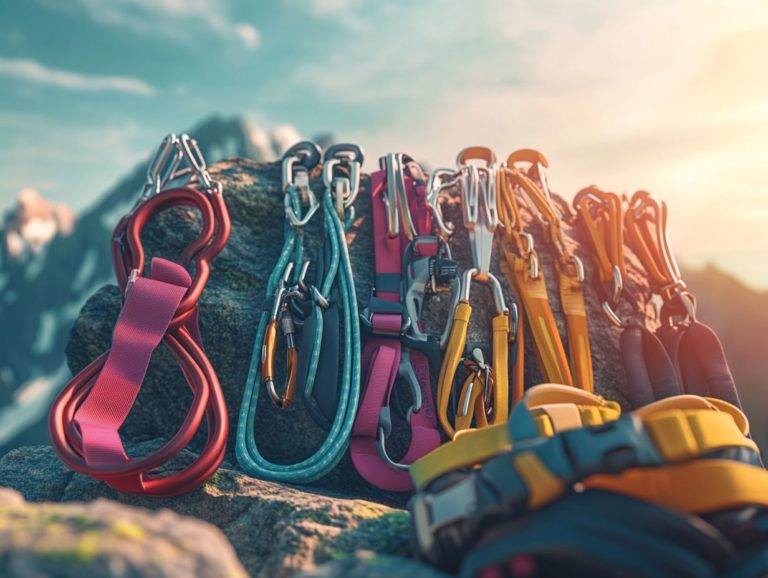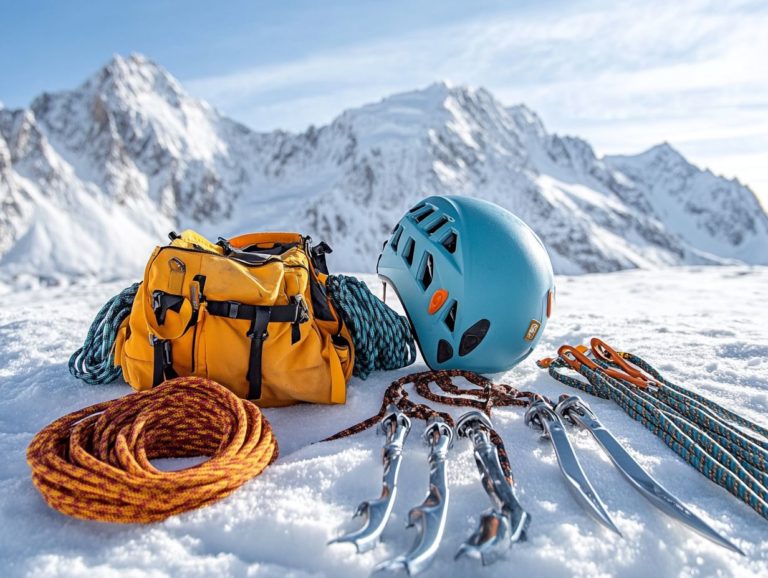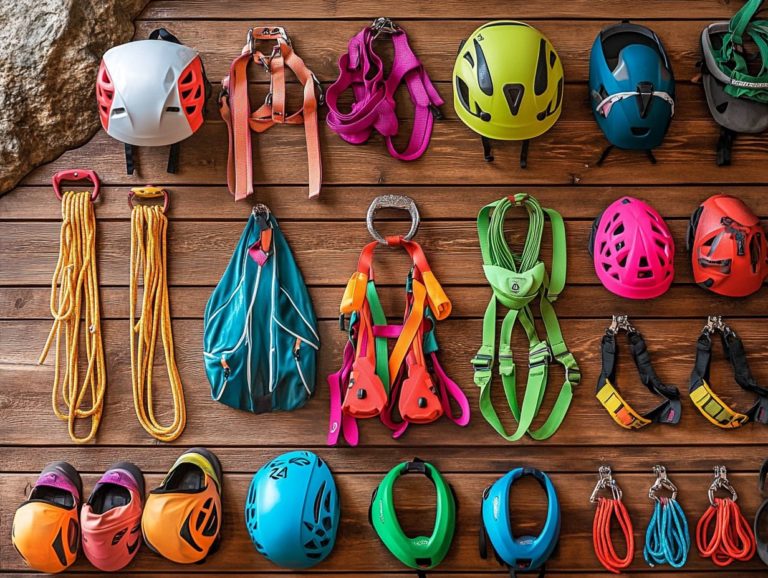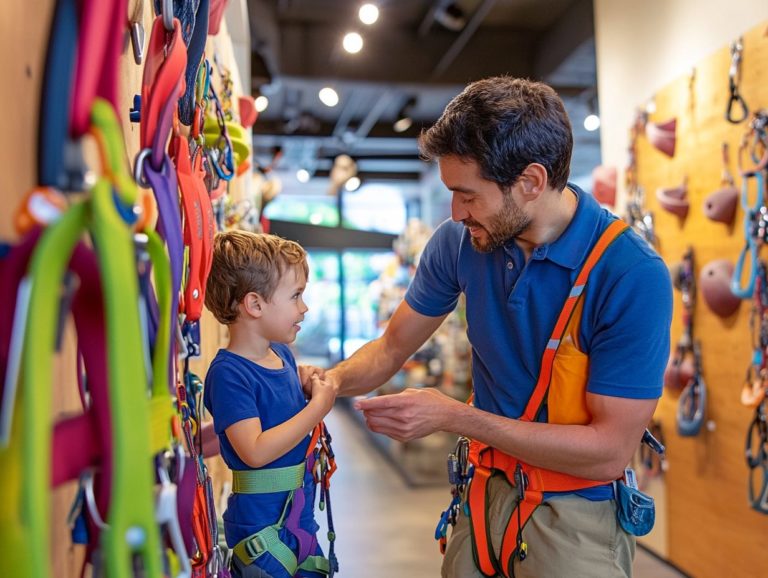5 Must-Have Accessories for Climbers
Climbing is an exhilarating adventure, and having the right gear can significantly enhance your safety and performance.
This article showcases five essential accessories every climber should consider: climbing shoes, chalk bags, harnesses, belay devices, and helmets.
Discover how to choose the perfect fit, grasp the benefits of each item, and ensure you re thoroughly prepared for your next ascent.
You ll also uncover tips on caring for your gear and identify common pitfalls to avoid. Get excited to gear up for your next climb!
Contents
- Key Takeaways:
- 1. Climbing Shoes
- 2. Chalk Bag
- 3. Climbing Harness
- 4. Belay Device
- 5. Helmet
- What Are the Different Types of Climbing Shoes?
- How Do You Choose the Right Size and Fit for Climbing Shoes?
- What Are the Benefits of Using a Chalk Bag?
- How Do You Choose the Right Climbing Harness?
- What Are the Different Types of Belay Devices and How Do They Work?
- Why Is a Helmet Important for Climbing?
- What Other Accessories Can Enhance Your Climbing Experience?
- How Can You Properly Care for Your Climbing Accessories?
- What Are Some Common Mistakes to Avoid When Using Climbing Accessories?
- What Are the Essential Items to Pack for a Climbing Trip?
- Frequently Asked Questions
Key Takeaways:
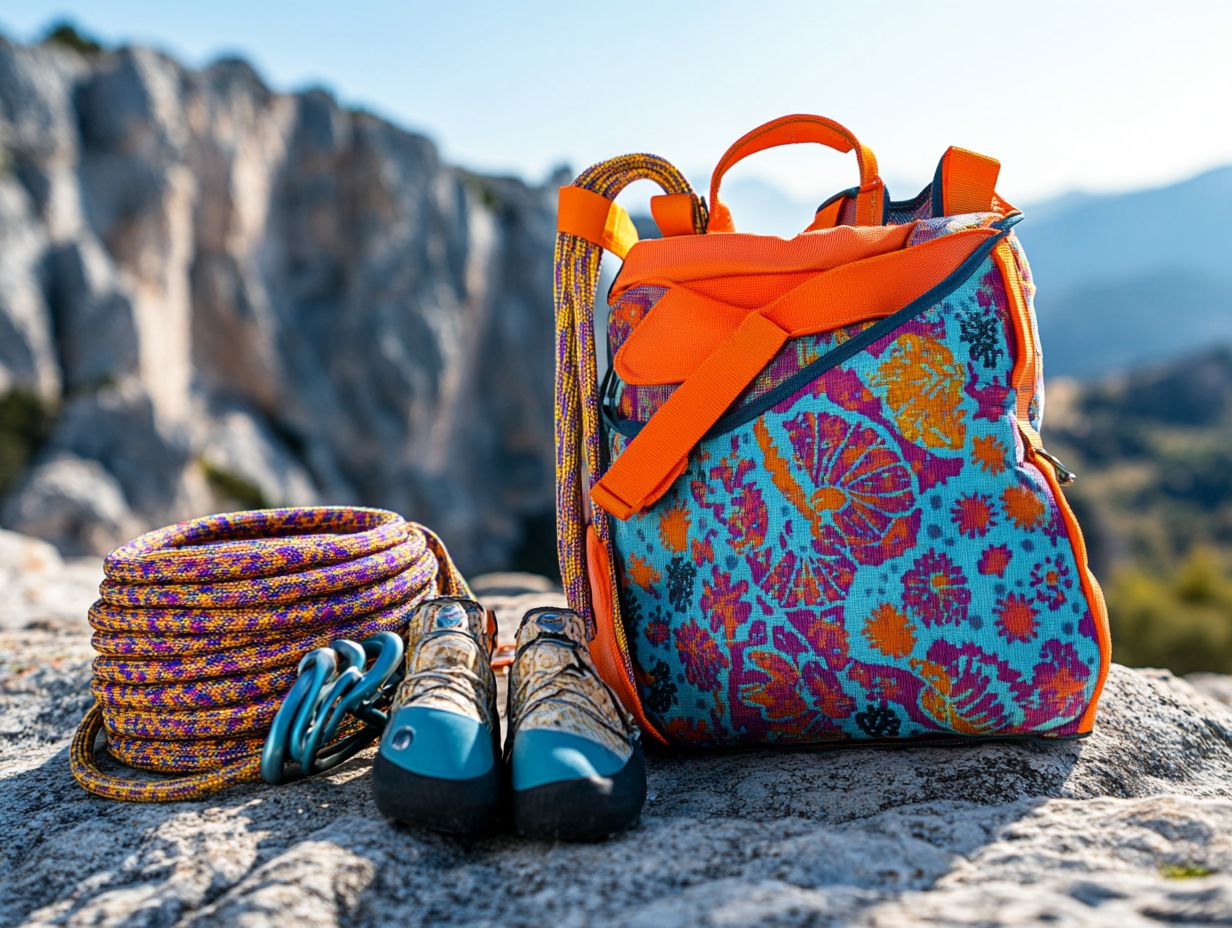
- Climbing shoes are crucial for climbers, with various types to choose from based on your climbing style.
- A chalk bag enhances grip and prevents slipping, with options for waist and harness attachment.
- A well-fitted climbing harness is essential for comfort and safety, available in different types and sizes.
1. Climbing Shoes
Climbing shoes are a critical part of your gear, carefully designed to improve safety and performance during rock climbing and bouldering. The right pair can transform your grip, comfort, and control, making it a crucial investment whether you’re just starting out or have years of experience under your belt.
With esteemed brands like Evolv, Five Ten, SCARPA, and La Sportiva offering a diverse array of styles, you can select the ideal climbing shoes tailored to your unique climbing style and foot shape. This elevates your overall experience on the rock.
You ll find several types of climbing shoes available, such as sport climbing, traditional climbing, and bouldering. Sport climbing shoes usually feature a snug fit that maximizes sensitivity and power on steep routes. Trad climbing options strike a balance between comfort and performance, perfect for those longer ascents. For bouldering, you’ll want shoes with a design that helps with precise movements. The materials also vary; synthetic options deliver durability, while leather provides a more customizable fit.
Brands like Evolv and Five Ten have engineered shoes with distinctive features, ensuring that you can discover a model that perfectly aligns with your needs. This ultimately enhances your climbing performance and boosts your confidence on the rock.
2. Chalk Bag
A chalk bag is essential for climbers, offering a convenient way to keep climbing chalk within reach and enhance your grip during challenging ascents. Regularly using climbing chalk helps absorb moisture from your hands, preventing slippage and elevating your overall climbing experience.
With a plethora of chalk bag designs available from timeless classics to innovative creations you can select one that not only meets your functional needs but also complements your personal style.
The right chalk bag can truly elevate your climbing performance, allowing you to minimize distractions and concentrate on your technique. Features like adjustable straps, drawstring closures, and external pockets for your essentials enhance the functionality of these bags. Some designs even utilize unique materials for added durability and comfort.
In terms of choosing a chalk bag, your personal preference is paramount. Consider factors such as size, shape, and how easily you can access your chalk during an ascent. Ultimately, selecting the perfect bag improves your grip and boosts your confidence on the rock face.
3. Climbing Harness
The climbing harness is an essential piece of safety equipment that secures you to ropes and other safety systems, playing a vital role in your climbing safety measures. Whether you’re tackling outdoor climbs or navigating a bouldering gym, a properly fitted harness can significantly enhance your climbing experience by ensuring both comfort and security.
With various types of climbing harnesses available, each designed to cater to different climbing styles and preferences, it s crucial to choose one that aligns perfectly with your specific climbing activities.
Among the most common types are:
- Sport
- Trad
- Mountaineering
Each type is equipped with key features like belay loops for attaching the rope and gear loops for stowing all necessary equipment. If adaptability is your priority, consider models with adjustable leg loops that enhance fit and comfort.
When selecting a harness, keep your body type and climbing style in mind; a snug fit is crucial for safety, but be wary of going too tight, as it can hinder your movement. Regular safety checks are essential. Make it a habit to inspect your harness for wear and tear before each climb to ensure reliable protection on every ascent.
4. Belay Device
A belay device is a critical piece of climbing gear that enables you to manage controlled descents while keeping you safe. When paired with a safety harness and carabiners, these devices allow you to securely oversee another climber s ascent or descent, making them essential whether you’re scaling outdoor routes or navigating the bouldering gym.
With a variety of belay devices on the market, each designed for specific climbing scenarios, choosing the right one can significantly enhance both your safety and climbing performance.
Among the most common types are tube devices and assisted braking models. Tube devices are known for being simple and lightweight, and they are a favorite among many climbers due to their reliability and user-friendly nature. They excel in versatile rope management, making them ideal for sport climbing or traditional routes.
Conversely, assisted braking devices automatically lock the rope if there’s sudden force. This feature can be especially advantageous for less experienced belayers or during challenging climbing conditions. Learn the unique features of each type and practice proper techniques to ensure you re well-equipped to maximize safety and perform at your best across diverse climbing environments.
5. Helmet
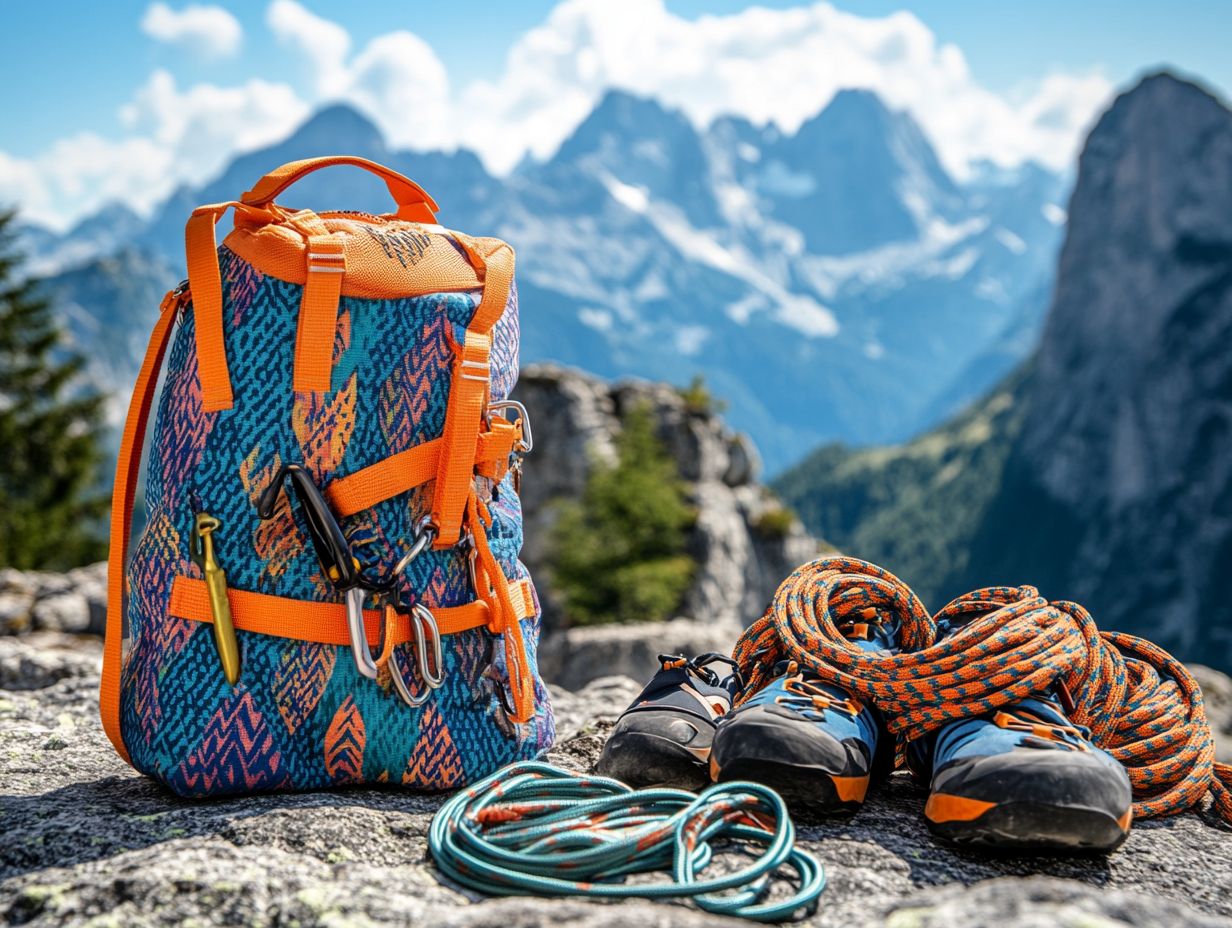
A climbing helmet is your essential safeguard against potential head injuries while you’re out enjoying rock climbing or bouldering. This highlights why safety is important in your climbing adventures. Designed to absorb impacts and shield you from falling debris, a helmet is an essential piece of gear, whether you’re just starting out or are a seasoned pro.
With reputable brands like Black Diamond and Metolius at your disposal, selecting the right helmet can significantly enhance your confidence while climbing, whether you’re tackling outdoor crags or indoor walls.
When you’re in the market for a climbing helmet, pay close attention to the materials used in its construction. Lightweight yet durable options like polycarbonate or EPS foam can make a world of difference in functionality. Ventilation is another vital feature to consider; a well-ventilated design keeps you cool during those strenuous climbs, while an adjustable fit ensures comfort for those longer ascents.
Regular inspections are crucial too, helping you spot any signs of damage or wear over time. Don’t take chances always wear a helmet! By prioritizing these factors when choosing your helmet, you’re not just meeting safety standards you’re also elevating your overall climbing experience, making every ascent more secure and enjoyable.
Make sure to invest in a quality climbing harness today!
Choose a helmet that suits your style and keeps you safe on every adventure!
What Are the Different Types of Climbing Shoes?
Climbing shoes come in a variety of types, each crafted to suit different climbing styles and terrains. Understanding these options can significantly elevate your climbing performance. Whether you need aggressive shoes for sport climbing or comfortable shoes for trad climbing, grasping the nuances between these choices is crucial for any climber aiming to refine their skills.
Renowned brands like SCARPA and La Sportiva offer an impressive array of choices, enabling you to find footwear that aligns perfectly with your unique needs.
Each type of shoe presents distinct features tailored to specific preferences and techniques. For example, aggressive models with their curved design and grippy rubber soles excel at precise foot placements on steep routes. However, they might not be the best choice for long climbs due to potential discomfort over time.
On the other hand, moderate shoes strike an ideal balance between performance and comfort. They are versatile enough for various climbing disciplines, including sport and trad. If you’re looking for comfort-oriented options, those are perfect for extended sessions on the rock, delivering durability and support without compromising performance.
By understanding these characteristics, you can make informed decisions tailored to your climbing aspirations.
How Do You Choose the Right Size and Fit for Climbing Shoes?
Finding the perfect size and fit for your climbing shoes is essential for an amazing climbing experience! Ill-fitting shoes can seriously hinder your climbing efficiency. When searching for the right fit, consider aspects such as shoe type, closure system, and the unique shape of your foot.
Brands like Evolv and Five Ten often offer specific sizing recommendations to guide you in making well-informed choices. It’s essential to understand foot anatomy climbers come in all shapes and sizes. Whether you have high arches, wide feet, or longer toes, each factor influences how a shoe should fit.
Personal preferences also play a significant role. Some climbers might prefer a snug fit for precision, while others may seek a more relaxed feel for longer sessions. Trying on multiple pairs is a smart move to find your best match.
Don t forget to consult brand-specific sizing charts, as these can vary significantly between manufacturers. Paying attention to these details will help you achieve the perfect balance of comfort and performance as you tackle the rock face.
What Are the Benefits of Using a Chalk Bag?
Using a chalk bag during your climbing adventures brings a wealth of advantages, such as improved grip, moisture reduction, and an overall boost in your climbing performance. With chalk readily at hand, you can concentrate on honing your technique rather than worrying about hand slippage.
The variety of chalk bag designs available caters to your personal preferences, making it a critical accessory for any climbing enthusiast. These bags help you switch grips smoothly, minimizing distractions that can often mean the difference between reaching the summit and succumbing to frustration.
You ll find an array of styles, from traditional drawstring closures to more advanced designs boasting adjustable waist belts for a secure fit. When selecting the perfect chalk bag, consider vital factors like bag size, material durability, and ease of access.
You might prefer a smaller, lightweight option for bouldering, while others may gravitate toward a larger bag with extra pockets for those long, rewarding routes. Ultimately, the right choice not only enhances your performance but also elevates your entire climbing experience.
How Do You Choose the Right Climbing Harness?
Choosing the right climbing harness is essential for ensuring your safety and comfort while you ascend. It directly impacts your security and mobility. With various styles and features at your disposal, evaluate your specific needs whether that s sport climbing, trad climbing, or bouldering to select the harness that suits you best.
Understanding the nuances in fit, padding, and gear loops can significantly enhance your climbing experience. A well-fitted harness should feel snug yet unrestrictive, allowing you the freedom to move during your climbs.
As you select a harness, consider the amount of padding and how it distributes pressure, particularly during extended use. Look for gear loops that are easily accessible so you can grab quickdraws or other equipment without compromising your movement.
To ensure optimal safety and comfort, test the harness by mimicking climbing movements. Adjust all straps and confirm that it stays securely in place without being too tight. Check for features like adjustable leg loops, which can make a significant difference in achieving that perfect fit.
What Are the Different Types of Belay Devices and How Do They Work?
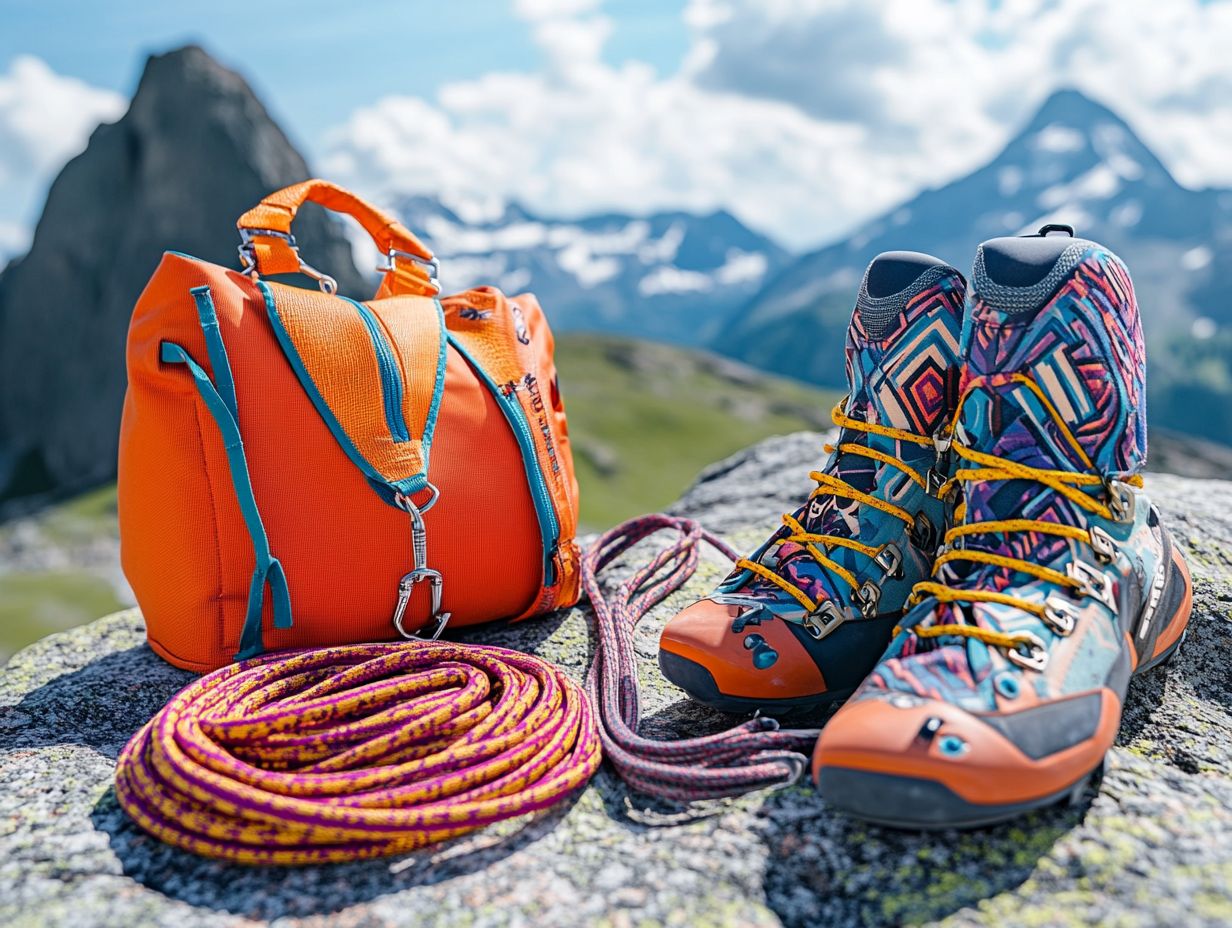
Belay devices come in various types, each expertly crafted to help you manage the rope during both ascent and descent, all while upholding essential safety measures. Understanding how each type works be it a tube-style device or a device that helps slow your fall automatically is key to staying safe!
Your selection of a belay device can vary dramatically based on the climbing scenario at hand. For instance, tube-style devices, known for their simplicity, excel in sport climbing but might demand your full attention when managing lead falls.
Conversely, assisted-braking devices provide an added layer of security, making them ideal for beginners or multi-pitch climbs where safety is paramount. It s worth noting that some devices are engineered for specific rope diameters, which can affect their performance.
Others offer enhanced control in situations involving dynamic movements. Each type boasts its own advantages and drawbacks, so understanding these nuances can significantly boost both your safety and performance in a variety of climbing environments.
Why Is a Helmet Important for Climbing?
A climbing helmet is essential for safeguarding you from head injuries by absorbing impacts and protecting against falling debris. This underscores the importance of climbing safety measures. Whether you’re scaling a rock face outdoors or tackling an indoor wall, wearing a helmet can significantly enhance your injury prevention and grant you peace of mind.
With a variety of models available, each boasting unique features, choosing the right helmet is crucial for your safety! Look for climbing helmets with certifications like UIAA (International Climbing and Mountaineering Federation) or CE (European Conformity), as this indicates they ve undergone rigorous safety testing.
Features such as ventilation ports, adjustable straps, and lightweight materials enhance your comfort without skimping on protection. Proper fit is crucial your helmet should sit snugly on your head, covering your forehead without sliding back.
Regular maintenance, including cleaning and inspecting for any damage or wear, ensures that your helmet remains reliable. This meticulous attention to detail not only maximizes your safety but also fosters a proactive mindset towards climbing, letting you fully immerse yourself in the adventure that lies ahead.
What Other Accessories Can Enhance Your Climbing Experience?
Along with essential climbing gear, various accessories can greatly improve your climbing experience. They ensure a safer and more enjoyable adventure.
Crash pads help protect you during bouldering. Climbing tape safeguards your hands and fingers, making climbs more comfortable.
A well-structured climbing pack keeps your gear organized and accessible. This allows you to focus on your climbing goals.
Invest in a reliable harness with adjustable leg loops. It provides a customizable fit and support for those long climbs.
Belay devices designed for climbs that take more than one pitch enhance braking power and ease of use. This ensures smoother transitions between routes.
Chalk bags are also worth considering. They prevent sweaty hands and improve grip, boosting your overall climbing performance.
Brands like Black Diamond and Petzl offer high-quality options. Explore them for a confident climbing experience.
By adding these accessories to your gear collection, you can elevate your performance and enjoy safer adventures.
How Can You Properly Care for Your Climbing Accessories?
Caring for your climbing accessories is crucial for their longevity. Proper maintenance significantly enhances your climbing experience.
Regularly check and clean your gear, including safety harnesses, climbing ropes, and chalk bags. This prevents accidents and ensures everything functions well.
Follow the manufacturer’s guidelines for care. Doing so enhances safety and extends the life of your climbing accessories.
Establish a routine to inspect your gear for wear or damage. Look out for fraying straps or compromised stitching.
After each climbing session, wash your gear with mild soap and water to keep it clean, especially items that gather dirt and sweat.
Proper storage is also important. Keep your equipment in a cool, dry place away from direct sunlight to prevent material degradation.
Schedule regular inspections before intense climbing seasons. This helps you proactively address issues and ensures your gear remains in peak condition.
What Are Some Common Mistakes to Avoid When Using Climbing Accessories?
Avoiding common mistakes with climbing accessories is essential for safety and performance. Misusing belay devices or neglecting to check harness adjustments can lead to accidents.
Understanding how to use gear properly can make a significant difference. Familiarize yourself with your equipment s recommendations and limitations.
Regular maintenance is critical. Clean your gear and inspect it for wear and tear to prevent failures.
Engaging in workshops or seeking advice from experienced climbers can help reinforce safe practices. This fosters a culture of safety in your climbing adventures.
What Are the Essential Items to Pack for a Climbing Trip?
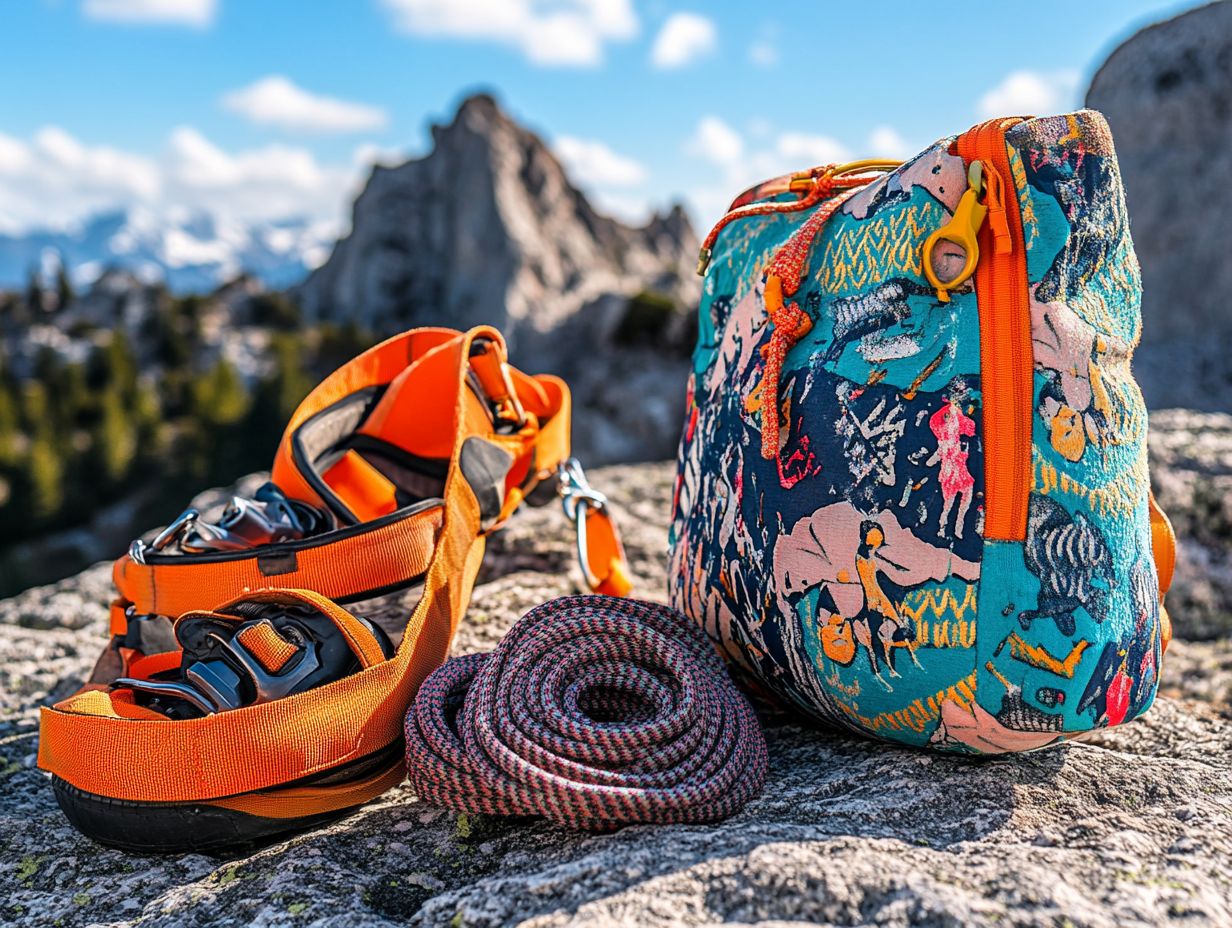
Packing the right essentials for your climbing trip is crucial. It ensures a successful and enjoyable experience.
Include climbing shoes, harnesses, safety gear, and personal items. Choosing the right gear keeps you prepared for outdoor climbing challenges.
Know the requirements for your climbing style. Whether sport climbing, bouldering, or traditional climbs, this knowledge helps you decide what gear to pack.
A chalk bag improves your grip. A climbing helmet protects against falls and flying debris.
Wear the right layers for changing weather. This prevents discomfort. Durable packs help you organize your gear.
Use packing cubes or dry bags for smaller items. This streamlines access and reduces clutter.
This method keeps essentials within reach. It also makes travel efficient, letting you focus on the thrill of climbing.
Frequently Asked Questions
What are the top 5 must-have accessories for climbers?
The top 5 must-have accessories for climbers include a harness, climbing shoes, a chalk bag, a helmet, and a rope.
Why is a harness essential for climbing?
A harness is essential for climbing because it helps distribute the climber’s weight and provides support while ascending or descending.
Do I need special shoes for climbing?
Yes, climbing shoes are designed with sticky rubber soles to provide the necessary grip and precision while climbing. They also have a tight fit for better control and sensitivity.
What is the purpose of a chalk bag in climbing?
A chalk bag is used to store and apply chalk on the hands to improve grip and prevent slipping while climbing. It also absorbs sweat and moisture.
Why is a helmet important for climbers?
A helmet is essential for protecting the head from falling rocks or any other objects while climbing. It should always be worn, even on easy climbs, as accidents can happen at any time.
What should I look for when choosing a climbing rope?
When choosing a climbing rope, look for the right length, diameter, and type suitable for the type of climbing you will be doing. It should also be strong, durable, and have a UIAA or CE certification for safety.
UIAA stands for the International Climbing and Mountaineering Federation, setting safety standards for climbing gear. CE certification indicates that the equipment meets European safety standards.

